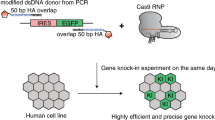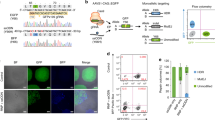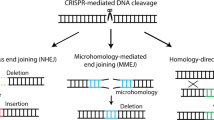Abstract
Oligonucleotide-based sequence alteration in living cells is a substantial methodological challenge in gene therapy. Here, we demonstrate that using corrective single-stranded oligonucleotides (ssODN), high and reproducible sequence correction rates can be obtained. CHO cell lines with chromosomally integrated multiple copy EGFP reporter genes routinely show rates of 4.5% targeted sequence correction after transfection with ssODN. We demonstrate that the cell cycle influences the rates of targeted sequence correction in vivo, with a peak in the early S phase during ssODN exposure. After cell division, the altered genomic sequence is predominantly passed to one daughter cell, indicating that targeted sequence alteration occurs after the replication fork has passed over the targeted site. Although high initial correction rates can be obtained by this method, we show that a majority of the corrected cells arrest in the G2/M cell cycle phase, although 1–2% of the corrected cells form viable colonies. The G2/M arrest observed after targeted sequence correction can be partially released by caffeine, pentoxifylline or Gö6976 exposure. Despite substantial remaining challenges, targeted sequence alteration based on ssODN increasingly promises to become a powerful tool for functional gene alterations.
This is a preview of subscription content, access via your institution
Access options
Subscribe to this journal
Receive 12 print issues and online access
$259.00 per year
only $21.58 per issue
Buy this article
- Purchase on Springer Link
- Instant access to full article PDF
Prices may be subject to local taxes which are calculated during checkout





Similar content being viewed by others
References
Kunzelmann K et al. Gene targeting of CFTR DNA in CF epithelial cells. Gene Therapy 1996; 3: 859–867.
Sangiuolo F et al. In vitro correction of cystic fibrosis epithelial cell lines by small fragment homologous replacement (SFHR) technique. BMC Med Genet 2002; 3: 8.
Campbell CR et al. Homologous recombination involving small single-stranded oligonucleotides in human cells. New Biol 1989; 1: 223–227.
Igoucheva O, Alexeev V, Yoon K . Targeted gene correction by small single-stranded oligonucleotides in mammalian cells. Gene Therapy 2001; 8: 391–399.
Moerschell RP, Tsunasawa S, Sherman F . Transformation of yeast with synthetic oligonucleotides. Proc Natl Acad Sci USA 1988; 85: 524–528.
Igoucheva O, Alexeev V, Yoon K . Oligonucleotide-directed mutagenesis and targeted gene correction: a mechanistic point of view. Curr Mol Med 2004; 4: 445–463.
Faruqi AF et al. Recombination induced by triple-helix-targeted DNA damage in mammalian cells. Mol Cell Biol 1996; 16: 6820–6828.
Nagatsugi F, Sasaki S, Miller PS, Seidman MM . Site-specific mutagenesis by triple helix-forming oligonucleotides containing a reactive nucleoside analog. Nucleic Acids Res 2003; 31: e31.
Seidman MM, Glazer PM . The potential for gene repair via triple helix formation. J Clin Invest 2003; 112: 487–494.
Chan PP et al. Targeted correction of an episomal gene in mammalian cells by a short DNA fragment tethered to a triplex-forming oligonucleotide. J Biol Chem 1999; 274: 11541–11548.
Datta HJ et al. Triplex-induced recombination in human cell-free extracts. Dependence on XPA and HsRad51. J Biol Chem 2001; 276: 18018–18023.
Olsen PA, McKeen C, Krauss S . Branched oligonucleotides induce in vivo gene conversion of a mutated EGFP reporter. Gene Therapy 2003; 10: 1830–1840.
Dekker M, Brouwers C, Te RH . Targeted gene modification in mismatch-repair-deficient embryonic stem cells by single-stranded DNA oligonucleotides. Nucleic Acids Res 2003; 31: e27.
Nickerson HD, Colledge WH . A comparison of gene repair strategies in cell culture using a lacZ reporter system. Gene Therapy 2003; 10: 1584–1591.
Nickerson HD, Colledge WH . A LacZ-based transgenic mouse for detection of somatic gene repair events in vivo. Gene Therapy 2004; 11: 1351–1357.
Alexeev V, Igoucheva O, Yoon K . Simultaneous targeted alteration of the tyrosinase and c-kit genes by single-stranded oligonucleotides. Gene Therapy 2002; 9: 1667–1675.
Igoucheva O, Alexeev V, Pryce M, Yoon K . Transcription affects formation and processing of intermediates in oligonucleotide-mediated gene alteration. Nucleic Acids Res 2003; 31: 2659–2670.
Liu L et al. Strand bias in targeted gene repair is influenced by transcriptional activity. Mol Cell Biol 2002; 22: 3852–3863.
Li XT et al. Identification of factors influencing strand bias in oligonucleotide-mediated recombination in Escherichia coli. Nucleic Acids Res 2003; 31: 6674–6687.
Brachman EE, Kmiec EB . DNA replication and transcription direct a DNA strand bias in the process of targeted gene repair in mammalian cells. J Cell Sci 2004; 117: 3867–3874.
Kalejta RF, Hamlin JL . The dual effect of mimosine on DNA replication. Exp Cell Res 1997; 231: 173–183.
Orren DK, Petersen LN, Bohr VA . A UV-responsive G2 checkpoint in rodent cells. Mol Cell Biol 1995; 15: 3722–3730.
Ferrara L, Kmiec EB . Camptothecin enhances the frequency of oligonucleotide-directed gene repair in mammalian cells by inducing DNA damage and activating homologous recombination. Nucleic Acids Res 2004; 32: 5239–5248.
Abraham RT . Cell cycle checkpoint signaling through the ATM and ATR kinases. Genes Dev 2001; 15: 2177–2196.
Kawabe T . G2 checkpoint abrogators as anticancer drugs. Mol Cancer Ther 2004; 3: 513–519.
Anderson HJ, Andersen RJ, Roberge M . Inhibitors of the G2 DNA damage checkpoint and their potential for cancer therapy. Prog Cell Cycle Res 2003; 5: 423–430.
Eastman A . Cell cycle checkpoints and their impact on anticancer therapeutic strategies. J Cell Biochem 2004; 91: 223–231.
Tenev T et al. Perinuclear localization of the protein-tyrosine phosphatase SHP-1 and inhibition of epidermal growth factor-stimulated STAT1/3 activation in A431 cells. Eur J Cell Biol 2000; 79: 261–271.
Acknowledgements
This work has been funded by the EU Grant QLK3-CT-2000-00634, and by a grant of the research council of Norway (NFR advanced research program). We thank James Booth and Solene Geraudie for reading through the manuscript and helpful discussions. Finally, we specially thank Dr Rolf Seljelid for valuable support.
Author information
Authors and Affiliations
Rights and permissions
About this article
Cite this article
Olsen, P., Randol, M. & Krauss, S. Implications of cell cycle progression on functional sequence correction by short single-stranded DNA oligonucleotides. Gene Ther 12, 546–551 (2005). https://doi.org/10.1038/sj.gt.3302454
Received:
Accepted:
Published:
Issue Date:
DOI: https://doi.org/10.1038/sj.gt.3302454
Keywords
This article is cited by
-
Analyses of point mutation repair and allelic heterogeneity generated by CRISPR/Cas9 and single-stranded DNA oligonucleotides
Scientific Reports (2016)
-
Combinatorial gene editing in mammalian cells using ssODNs and TALENs
Scientific Reports (2014)
-
Proliferation of Genetically Modified Human Cells on Electrospun Nanofiber Scaffolds
Molecular Therapy - Nucleic Acids (2012)
-
DNA Damage Response Pathway and Replication Fork Stress During Oligonucleotide Directed Gene Editing
Molecular Therapy - Nucleic Acids (2012)
-
Progress and prospects: oligonucleotide-directed gene modification in mouse embryonic stem cells: a route to therapeutic application
Gene Therapy (2011)



